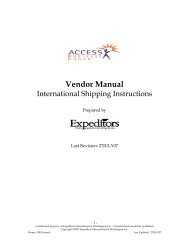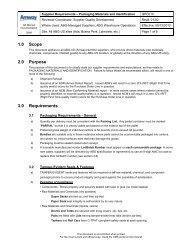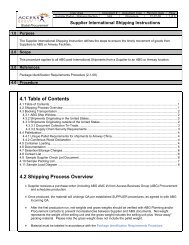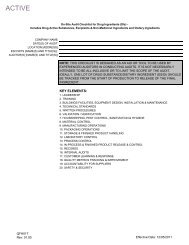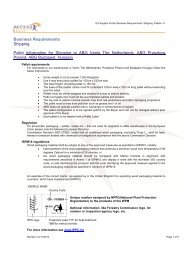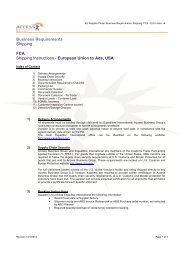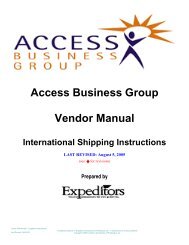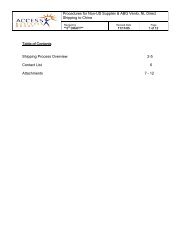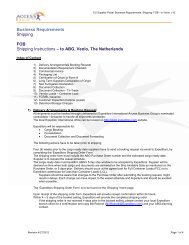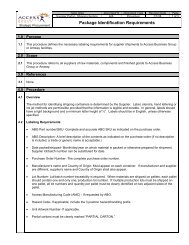FAQ - Supplier Portal - Amway
FAQ - Supplier Portal - Amway
FAQ - Supplier Portal - Amway
- No tags were found...
You also want an ePaper? Increase the reach of your titles
YUMPU automatically turns print PDFs into web optimized ePapers that Google loves.
Frequently Asked Questions (<strong>FAQ</strong>)I. How does <strong>Amway</strong> take credit for material that is rejected and sent back to the supplier?II. What is a quality rating?III. What are considered poor quality ratings and what happens if I have poor ratings?IV. What is a nonconforming product or material?V. What is a DMDO?VI. What is a Corrective Action/Preventive Action (CAPA)?VII. How does a DMDO affect my quality rating?VIII. When and how should I provide a C of A?IX. How do I know what test I have to run?X. What is a C of M?XI. When and how should I provide a C of M?XII. When do I have to provide a notification of process change?XIII. What is the Material Certification program?XIV. Why do I have to conduct process capability analysis?XV. What are Current Good Manufacturing Practices (cGMP)?XVI. What is HACCP?Version 2Updated: April 2008 1
I. How does <strong>Amway</strong> take credit for material that is rejected and sent back tothe supplier?If product does not meet specifications and is returned to the supplier at time of receipt, ABGwill not pay the supplier’s invoice (Please refer to the back of the purchase order for informationon product inspection and audit). However, if the product is determined to be non-conformingafter it has already been received and the supplier’s invoice has already been paid, the supplierwill be charged back on a subsequent check and a copy of the DMDO with charge back amountsnoted will be included with the check. If there are no outstanding invoices, the supplier isresponsible for reimbursement of any outstanding debit balances that remain on their account.For goods rejected upon receipt and returned to the supplier for rework at a non-ABG location,the supplier will credit ABG for the returned goods and issue an invoice for the quantity shippedback to ABG.For more information on DMDOs, please refer to the Business Requirements > Quality >Nonconforming Products and Materials (DMDO) section of the <strong>Supplier</strong> <strong>Portal</strong>.Return to TopII.What is a quality rating?The quality rating is a rating that is calculated based on quantitative metrics that measuresupplier performance in areas that have a significant impact on supply chain operations. Thesemetrics are outlined on the supplier scorecard.For more information on Quality Ratings, please refer to the Business Requirements > Quality ><strong>Supplier</strong> Quality Development Program/Performance Rating section of the <strong>Supplier</strong> <strong>Portal</strong>.Return to TopIII.What are considered poor quality ratings and what happens if I have poorratings?ABG expects that its suppliers have an overall quality rating of 99% or better, so anythingbelow this goal would be considered below average. Consistently poor ratings can lead to achange in the suppliers’ segmentation, which affects the business relationship between thesupplier and ABG.For more information on Segmentation, please refer to the Supply Management > Segmentationsection of the <strong>Supplier</strong> <strong>Portal</strong>.Return to TopVersion 2Updated: April 2008 2
IV.What is a nonconforming product or material?A nonconforming product or material is any purchased product or raw material received by ABGthat does not conform to the specifications or agreed upon standards.For more information on Nonconforming Product or Material, please refer to the BusinessRequirements > Quality > Nonconforming Products and Materials (DMDO) section of the<strong>Supplier</strong> <strong>Portal</strong>.Return to TopV. What is a DMDO?A DMDO is an order that is generated when components, raw materials and products do notconform to established specifications or standards. This tool is used to notify internal andexternal parties involved of the issue.For more information on DMDOs, please refer to the Business Requirements > Quality >Nonconforming Products and Materials (DMDO) section of the <strong>Supplier</strong> <strong>Portal</strong>.Return to TopVI.What is a Corrective Action/Preventive Action (CAPA)?CAPA is a term ABG uses to refer to a process where by the supplier responds to a DMDO issueand creates an action plan that focuses on preventing the nonconformance from occurring again.For more information on CAPAs, please refer to the Business Requirements > Quality >Nonconforming Products and Materials (DMDO) section of the <strong>Supplier</strong> <strong>Portal</strong>.Return to TopVII. How does a DMDO affect my quality rating?The disposition selected for the DMDO will determine how much the DMDO will affect yourquality rating.Please refer to the Business Requirements > Quality > Nonconforming Products and Materials(DMDO) section of the <strong>Supplier</strong> <strong>Portal</strong> for information on severity factors.Return to TopVersion 2Updated: April 2008 3
VIII. When and how should I provide a C of A?A non-historical C of A is required for every consumable raw material shipment received at ourfacility and should be attached to the shipping documents and emailed to the appropriate QApersonnel.For more information on when and how to provide C of As, please refer to the BusinessRequirements > Quality > Certificate of Analysis (C of A) section of the <strong>Supplier</strong> <strong>Portal</strong>.Return to TopIX.How do I know what test I have to run?The tests required for each product or material is laid out in the specifications.For more information on C of As, please refer to the Business Requirements > Quality >Certificate of Analysis (C of A) section of the <strong>Supplier</strong> <strong>Portal</strong>.Return to TopX. What is a C of M?A C of M is a certification used by a finished good supplier to indicate any deviations to theprocess or formula laid out in the specifications.For more information on C of Ms, please refer to the Business Requirements > Quality >Certificate of Conformance/Manufacture section of the <strong>Supplier</strong> <strong>Portal</strong>.Return to TopXI. When and how should I provide a C of M?A certificate of manufacture is required for all finished good shipments (e.g. SOFTGEL andTWO PIECE shipments) and should be included with the shipping documents.For more information on when and how to provide C of Ms, please refer to the BusinessRequirements > Quality > Certificate of Conformance/Manufacture section of the <strong>Supplier</strong><strong>Portal</strong>.Return to TopVersion 2Updated: April 2008 4
XII. When do I have to provide a notification of process change?Notification of process change requests should be made to your ABG R&D, Procurement orSQD representative at least 3 months before the change occurs.For more information on Notification of Process Change, please refer to the BusinessRequirements > Quality > Notification of Process Change section of the <strong>Supplier</strong> <strong>Portal</strong>.Return to TopXIII. What is the Material Certification program?In an effort to achieve higher levels of quality while at the same time maintain cost, ABG haslaunched a material certification program. Products certified under this program will be receivedas “on hand” at our facility.For more information on the Material Certification Program, please refer to the BusinessRequirements > Quality > Material Certification Program section of the <strong>Supplier</strong> <strong>Portal</strong>.Return to TopXIV. Why do I have to conduct process capability analysis?By conducting process capability analysis, suppliers can monitor the key characteristics andparameters of a product to help them fully understand the product and its variations. In depthknowledge of the product will allow suppliers to proactively prevent non-conformance.Furthermore, it is an excellent tool to demonstrate the extent of an improvement made to aprocess.For more information on Process Capability, please refer to the Business Requirements > Quality> Process Capability section of the <strong>Supplier</strong> <strong>Portal</strong> or contact your <strong>Supplier</strong> QualityDevelopment Representative.Return to TopXV. What are Current Good Manufacturing Practices (cGMP)?Current Good Manufacturing Practices are Food and Drug Administration regulations designedto protect the public from “adulterated” or potentially dangerous foods, drugs and cosmetics.cGMP regulations address issues relating to recordkeeping, personnel qualifications, sanitation,cleanliness, equipment verification, process validation and complaint handling.Version 2Updated: April 2008 5
For more information on cGMPs, please refer to the Business Requirements > Quality >Additional Nutrition and Food Requirements section of the <strong>Supplier</strong> <strong>Portal</strong>.Return to TopXVI. What is HACCP?Hazard Analysis and Critical Control Point (HACCP) is a management system in which foodsafety is addressed through the analysis and control of biological, chemical, and physical hazardsfrom raw material production, procurement and handling to manufacturing, distribution andconsumption of the finished product. This systematic approach is used to identify, evaluate, andcontrol food safety hazards.For more information on HACCP, please refer to the Business Requirements > Quality >Additional Nutrition and Food Requirements section of the <strong>Supplier</strong> <strong>Portal</strong>.Return to TopVersion 2Updated: April 2008 6



